Art & Exhibitions
Berlin Gallery Weekend 2016 Bigger than Ever, as City’s Chasms Deepen
Does Berlin still need its edge to attract the art world?
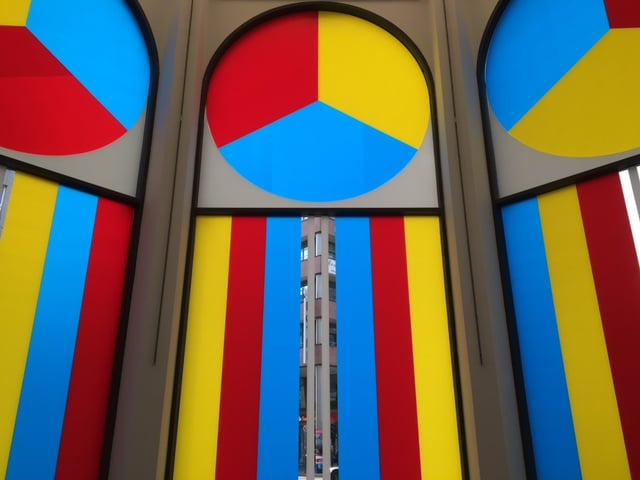
Does Berlin still need its edge to attract the art world?

As the 12th iteration of Berlin Gallery Weekend came to a close this past Sunday evening, it was once again clear that the homegrown format is the city’s uncontested golden egg, capable of attracting deep-pocketed collectors to a largely collector-less capital. It is very unlikely that Berliners will let something like a scheduling clash with Art Cologne in 2017 let the goose that lays it be taken away from them.
Counting some 54 participating galleries, and a host of openings not officially on the schedule, the weekend became longer than ever this time, with some events kicking off as early as Tuesday—for better or for worse. But come Monday morning, when the armies of gallery goers got back to their daily routines, collectors and artists left, and what seems to be the entirety of Berlin’s local art scene boarded an airplane to New York and headed to Frieze, what’s left is the deepening impression that the many fascinating contradictions that had characterized the city have now crystallized into chasms—social, ideological, and aspirational.
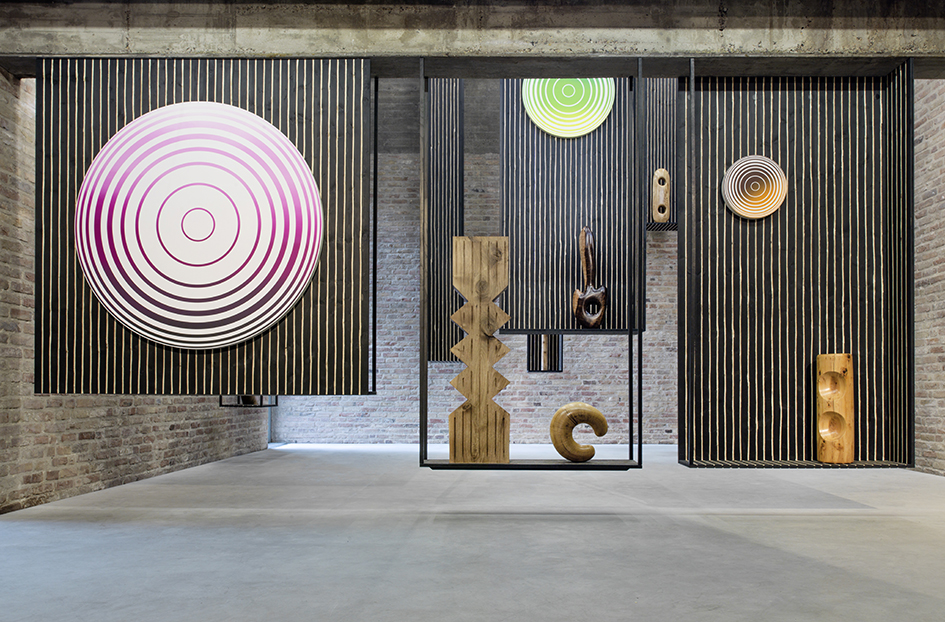
Claudia Comte, “Catch the Tail by the Tiger.” Courtesy Galerie König.
Nothing manifested this better than arriving on Sunday afternoon in the district of Kreuzberg—where traditional May Day demonstrations, powered by cheap booze, started to take over the streets, and German riot police blocked off major traffic arteries—to find Jay Jopling getting out of the limousine conspicuously blocking the driveway to Galerie König.
In what is surely Berlin’s fastest-expanding art enterprise, Johann König inaugurated a new sculpture garden for Gallery Weekend, with works by Tatiana Trouvé, Elmgreen & Dragset, Katharina Grosse, Alicja Kwade, Jeppe Hein, and more installed around the Brutalist former church that houses the gallery as well as his home. Inside, a charming first show by Claudia Comte blurred the boundaries between sculptural artworks and the exhibition’s design, while the rest of the gallery space functioned as an open showroom, and a show by Anette Kelm which opened several weeks ago continued upstairs.
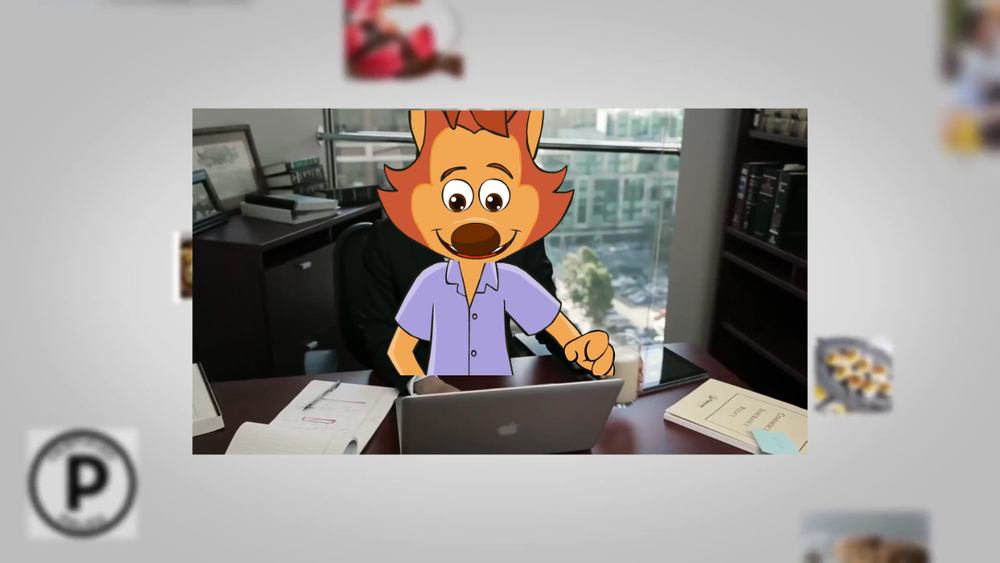
Ed Fornieles, “Der Geist: Flesh Feast,” video still, 2016. Courtesy Arratia Beer.
A generational gap was also at play, and nowhere was it more palpable than on Berlin’s congested gallery block along Potsdamer Strasse. Some artists tagged as post-Internet underwhelmed with shows that felt like one-liners at best, and lazy at worst. An exhibition by Petra Cortright at Société, hyped on countless pre-Gallery Weekend lists of must-see shows, was nothing short of a letdown. Meanwhile, at Arratia Beer, the otherwise enthralling—and entertaining—Ed Fornieles offered his musings on the topic of self-optimization through dietary means, using a good-natured fox avatar to drive home a point about consumption versus being consumed, which simply fell flat. His problematic show raised questions about how to break away as an artist from generational markers and tropes that can effectively be summed up in memes.
At Tanya Leighton, Aleksandra Domanović managed the leap more gracefully. The artist collaborated with photographer Spencer Lowell on images taken at the facility at UC Davis in California where the first genetically edited calves are being raised, designed to not grow horns so as to help pack more cows into pens and lower costs for farmers. Domanović created sculptures for the show as well, based on gestures she found in classical Greek statues, holding fruit and other offerings signifying prosperity and fertility.
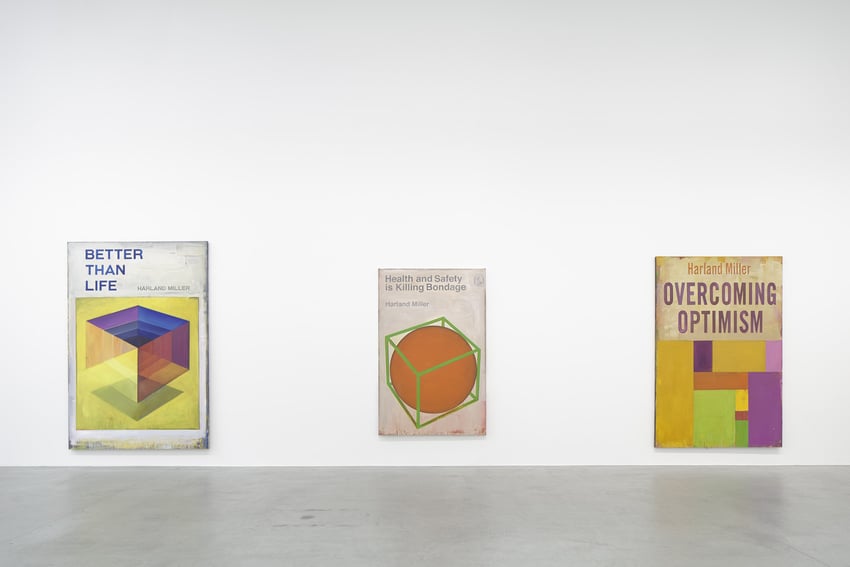
Installation View of Harland Miller, “Tonight We Make History (P.S. I Can’t Be There)” (2016). Courtesy the artist and Blain|Southern. Photo: Jörg von Bruchhausen.
In the context of searching questions about the contradictions of our day and age, which sees technology galloping forward while all over the world political and religious views are increasingly devolving into fanaticism and xenophobia, a series of paintings by author and artist Harland Miller at Blain|Southern struck a chord. His formula is simple, pithy, and effective: Miller paints large-scale canvases depicting invented Penguin-logoed book covers, which connect geometrical shapes with sardonic titles. Happiness The Case Against, or Overcoming Optimism (all works 2016) require no further unpacking, but a title like Health and Safety is Killing Bondage functioned as a wonderful comment on trigger warnings, linguistic self-censorship, and even the unsettling parallels between identitarian lines of argumentation and right-wing essentialism. My viewing experience was surely enhanced by the fact that, as I was standing in the gallery, a headline appeared on this site about a teacher losing her job for repeating the word vagina while speaking about Georgia O’Keefe’s work.
Another title by Miller, If Your Past Were On Fire Would You Go Back To Save It, stood in dialogue with several shows on view at other galleries, most directly perhaps with an exhibition by Michael Rakowitz at Barbara Wien. In his “The invisible enemy should not exist,” Rakowitz reconstructed artifacts from the collection of Baghdad’s National Museum of Iraq, that were looted, destroyed, or otherwise disappeared in the chaos and destruction since the war broke out in 2003.

Installation view of Michael Rakowitz, “The invisible enemy should not exist” (2007 – ongoing). Photo: Nick Ash, Berlin; Courtesy: Barbara Wien, Berlin.
His papier-mâché replicas are based on the artist’s research of pictures and documentation of missing objects in the University of Chicago’s Oriental Institute’s database and from the Interpol’s website. The replicas are arranged in the gallery like in a museum display, complete with informative labels. On closer inspection, one finds quotes by Donald Rumsfeld, about the price of freedom, and by Dr. Donny George Youkhanna, who dedicated his time to recovering the missing artifacts until his death in 2011.
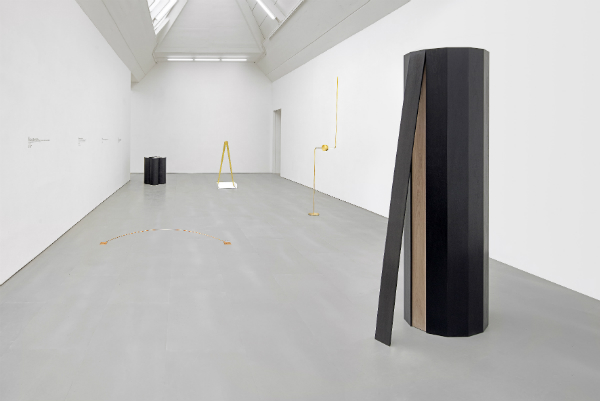
Iman Issa, Heritage Studies, exhibition view 2016 at carlier | gebauer, Berlin. Photo: Gunter Lepkowski.
Over at carlier | gebauer gallery, Cairo and New York based artist Iman Issa’s sumptuous sculptures continued the investigation of material heritage—and the unimaginable impacts of its loss—and the ways in which their links to loci, sites, and cultures provide a dynamic reading of history. Elsewhere, other forms of obliterations were adressed, like state-censorship in documentation of the poignant performance by Polish duo KwieKulik from 1978, titled The Monument Without a Passport.
Indeed, politics was never far away at this year’s edition. Wolfgang Tillmans lined the walls of the stairwell leading to Galerie Buchholz with posters he recently disseminated online to mobilize UK citizens to vote against Brexit. Inside the gallery, Tillmans offered glimpses into the day-to-day of his work at the studio, mixing art production and editorial work, and peppered with evidence of the bohemian disregard for one’s health. I was particularly touched by photographs of models built ahead of major exhibitions to arrange the hanging, and the insights they provide.
There was a lot of photography on view this year, with splendid shows by Anne Collier at Galerie Neu and Christopher Williams at Capitain Petzel. At BQ gallery, Jochen Lempert offered a meditative repose from my ludicrous attempt to see everything on view in one weekend, with his black-and-white prints capturing biological phenomena with a style that is the philosophical and aesthetic opposite of scientific documentation.
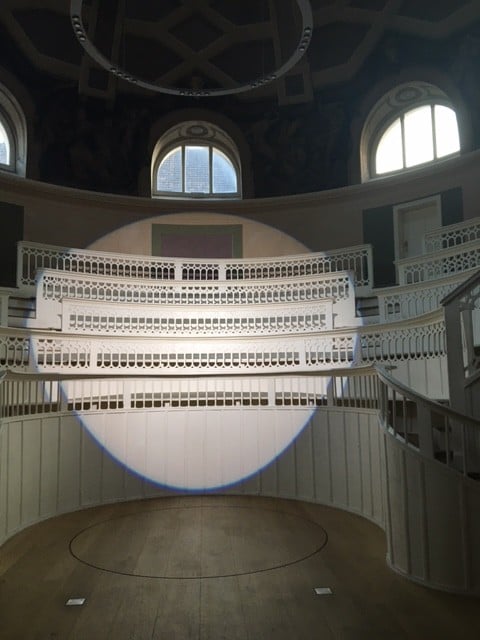
Michel Verjux at the Tieranatomisches Theater. Photo: Hili Perlson.
Thus, encouraged to seek out more quietude, I made my way to the Tieranatomisches Theater, an 18th century veterinary anatomy operation theater belonging to the Humboldt University that serves as an exhibition space. There, French artist Michel Verjux projected a circle of white light unto the theater’s opulent interior. With this simple gesture, Verjux flattens the space, as if using the entire room as his canvas. Behind the theater, Verjux projects another circle onto the wall of a huge storage room, that his gallerist Xavier Laboulbenne tells me was used in the former GDR as a facility to control meat quality.
And there it was, what was missing from this year’s uber-professional edition of Gallery Weekend: the sense of adventure, of exploration, that Berlin seems less and less able to provide. This sentiment was only strengthened by the fact that on Saturday night, gallery Isabella Bortolozzi and Galerie Neu hosted a party in the former Funkhaus, a uniquely preserved building where all early German radio broadcasting was done initially, and which served as home to the GDR’s radio station from the mid-1950s until the 1990. After a turbulent post-Cold-War history which saw the building mismanaged by the bankrupt city of Berlin (and a few raves at the site), the Funkhaus was finally bought last year by a private investor. Time will tell what he has in store for it, but must the art world be so closely linked to real estate development?
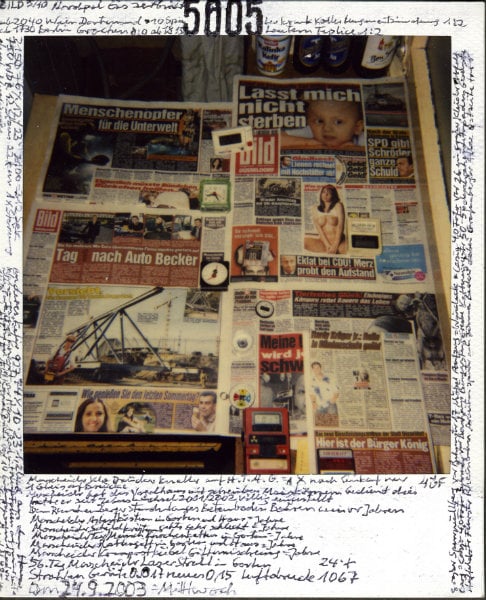
Horst Ademeit, 5805, 24.9.2003. Copyright Delmes & Zander
Just like in last year’s edition, a show at Delmes & Zander gallery, which specializes in outsider art, brought some sense of nostalgia for the unpolished and different, which used to be Berlin’s strengths along with cheap rents, all gone now. (A major German collector recently told me that the city’s real estate is too expensive for the private museum he is looking to open, if you require more proof). The gallery showed Horst Ademeit (1937-2010) who devoted 40 years of his life to obsessively keeping record of information that he believed would establish the existence of “cold rays,” invisible forces that he claimed severely impaired and impacted upon his life and surroundings.
Other note-worthy shows around gallery week included Hanne Darboven at Galerie Crone; Edmund de Waal at Galerie Max Hetzler; Daniel Buren at Buchmann Galerie and Thomas Schulte; Ghada Amer at Kewenig; Rachel Harrison at AKTNZ; and Adriano Costa at Supportico Lopez, in addition to the ones already reported on in part I.